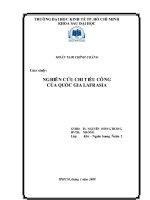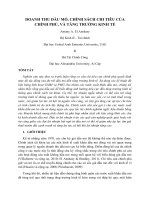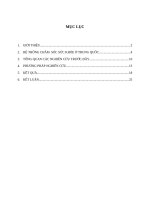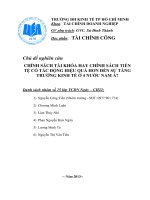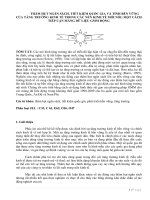Tiểu luận tài chính công military budget of japan
Bạn đang xem bản rút gọn của tài liệu. Xem và tải ngay bản đầy đủ của tài liệu tại đây (341.91 KB, 15 trang )
Military budget of Japan
1. Overall of public finance of Japan
1.1. Assessment of public finance of Japan from 2012-2017
Looking at the current economic situation, some bright signs can be seen in the
Japanese economy. From the viewpoint of developing this trend of economic
recovery into sustained economic growth driven by the private sector, it is important
to implement comprehensive policy measures such as revitalization of the economy,
establishment of sustainable public finance which would not pass the current burden
on to the future generation, and so on.
From 2012, the budget of Japan aimed to realize both economic revitalization and
fiscal consolidation with the combination of the economic stimulus package, FY2011
supplementary budget, and FY2012 tax reform (The Government aims to halve the
primary deficit of the central and local governments to GDP ratio (-4.3%) by FY2012
from the ratio in FY2010 (-6.6%)).
They did it through the period of the next 5 years but with the different capital for
each fields. In general, the main subjects are :
Enhancing medical and long-term cares ⇒ Enhancing social security by utilizing
revenues from consumption tax increase: AG total 1 trillion yen in FY2012, increase
by almost 800 billion yen in FY2016.
Moreover, they focused on realizing “a society in which all citizens are
dynamically engaged”, enhancing childcare support and providing nursing services
directly linked to the “Desirable birthrate of 1.8” and “No one forced to leave their
jobs for nursing care” and also reducing the burden of education costs. In 2017, there
are 6 things which they want to improve such as raising wages for childcare and longterm nursery workers; expand capacity of childcare facilities, so as to reduce the
number of children on the waiting list; shorten the minimum eligible period for
receiving pension from 25 to 10 years; lengthen the eligible period for maternity
leave benefits; reduce the employment insurance payments; and introduce a new
government-sponsored scholarship.
Promoting measures for disaster prevention and reduction as well as for aging
infrastructure. Accelerating reconstruction from the Great East Japan Earthquake and
revitalization of Fukushima in the FY2015 and 2016. Rebuild and improve the living
standard of the citizen. Along with the restruction, Japanese government not only
promoted measures for disaster prevention and mitigation as well as for maintenance
of aging infrastructure, but also improved the quality of education and reinforcing
scientific and technological capabilities.
In 2015, securing the same level of expenditures for public works as that of
FY2014 (5971.1 billion yen (+0.0%)). Promoting the measures for disaster prevention
and reduction as well as for the aging infrastructure. Strengthening international
competitiveness through developing effective logistics network systems.
Construction of new Shinkansen lines will be decided ahead of the planed schedule
while constraining the increase in the government’s expenditure. In the next year,
securing public works related expenditure (5,973.7 billion yen (%0.0%)) at the same
level compared with previous fiscal year, while enhancing measures for disaster
prevention and mitigation as well as maintenance of aging infrastructure in a planned
manner. In addition, facilitating logistics networks which provoke private investments
and activate the economy.
And the last one that Japan focused on is military. From 2012 to 2017, the capital
which they used for increasing budget for national defense to steadily enhance
defense capability increased from 41 billions to 43 billions dollars. In 2015, The
Japan’s Government focus on enhancing patrol and monitoring ability and reinforcing
the defense for islands through establishing the coastal monitoring system. And with
the increase of budget on military, In 2016, they strengthened the defense system
along with the “Medium Term Defense Program.” Promoting the projects regarding
US military realignment in order to reduce the burden on Okinawa.
1.2. Japanese Public finance facts in 2017
Out of the total expenditure, the sizes of social security expenditure and national
debt services have increased in recent years, while the proportion of other policy
expenses (public works, education and science, and national defense, etc.) has
decreased during the same period. National debt services, local allocation tax grants,
and social security expenditures now account for more than 70% of the total
expenditure.
Chart 1
In the FY2017 budget, tax revenue (general account) is estimated to be around 58
trillion yen. Tax and other revenues, which should, under normal circumstances, fully
finance the government expenditure in a given year, account for about two-thirds of
the revenue only. As a result, the remaining one-third relies on debt financing (i.e.,
revenue generated by issuing government bonds), which constitute a burden for future
generations.
Chart 2
The outstanding amount of Japan’s government bonds has increased year after
year, reaching ¥865 trillion at end FY2017 (projected), which is 15 times as large as
the annual tax revenue. This accumulated debt will impose heavy burden on future
generations.
Chart 3
Japan’s gorvernment has to deal with some Problems of Fiscal Deficit:
Fall in the level of public services
If the national debt service cost increases, other expenditure items would be
squeezed, lowering the level of public services that are essential for people’s lives,
such as social security, education, national defense, and infrastructure development.
Moreover, the government would have difficulties in fulfilling its obligation to carry
out its fiscal functions, even in the event of a disaster or an economic crisis. Increase
in fiscal deficit and debt outstanding.
Inter-generational inequality
If the current generation resorts to debt-financing for receiving their social
security benefits (e.g., pensions for elderly people and medical and long-term care),
the burden of debt repayment would be passed to future generations. Consequently,
these future generations would need to pay back a huge amount of debt, thus suffering
from reduction in benefit and increase in burden with regard to the social security.
If the current imbalance between benefits and contributions remains unchanged,
Japan’s universal health care and pension coverage, which is one of the best in the
world, cannot be sustained till the next generation.
Loss of private sector’s economic viability
If confidence in public finance is lost and consequently government bonds are
downgraded, bank and other corporate bonds would be also downgraded, resulting in
a rise in the cost of corporate bond financing.
If the government continues to absorb private funds by issuing deficit-financing
bonds, funds necessary for enhancing growth would not be channeled to the private
sector, hurting private sector’s economic viability.
Increase in interest rates due to the deterioration of confidence in public
finance
If an increase of the outstanding stock of debt leads to deterioration of confidence
in public finance, interest rates would rise drastically, thereby having an adverse
impact on the economy.
For example, financial institutions, which hold large amount of government
bonds, would incur losses in the value of their assets. As a result, financial system
would become unstable. Moreover, government bond investors would leave the
market, making it difficult for the government to raise funds.
2. Military budget of Japan
2.1 Reality
In recent time, Japan Ministry of Defense has continuously proposed to raise the
military expenditures to the recorded amount for five years in a row. After the long
term fall in military spending, it was noted that Japan has become increasingly
sophisticated and self-sufficient military power. The military’s shopping list includes
drones, surveillance aircraft, F-35 stealth fighters, submarine and money for land to
build a new military base on a remote island. It was also stated that this was no longer
an era when Japan is permitted to do nothing and count on America to protect them.
According to the awareness of the serious nearby Japan security environment, they
decided to invest in the latest US-developed ballistic missile interceptors for its shipbased Aegis missile defense system and also poured money into upgraded groundbased ballistic missile interceptors.
According to Japanese security policy, maintaining a military establishment is
only one method -- and by no means the best method -- to achieve national security.
Diplomacy, economic aid and development, and a close relationship with the United
States under the terms of the 1960 security treaty are all considered more important.
Japan is keeping military expenditure at only 1% of GDP, even though this is still a
very significant amount. Japan's posture is a defensive one, with no weapons of mass
destruction, no long-range bombers, no middle or long-range missiles, no aircraft
carriers and no nuclear submarines. But Japan has considerable conventional
weapons, and wants to use its Self-Defense Forces for peacekeeping operations.
Japan is however very concerned over the military build-up in East Asia.
Defense-related expenditures include spending for maintaining and managing the
SDF, improving living conditions in the neighborhoods of defense facilities, and
supporting U.S. forces in Japan. In FY2013, defense-related expenditures, which had
been declining continuously since FY2003, were increased in real terms for the first
time in 11 years, in order to reinforce preparedness aimed at protecting the lives and
property of the populace and the nation’s land, sea, and airspace, in light of the
increasingly harsh security environment.
Generally speaking, JSDF (Japan self defense force) expenditure on weaponry
acquisition in 2012 maintained the level of the previous year. It also followed the
general trend of the recent years, emphasizing the development of naval and air
weapons systems. According to Japan’s National Defense 2012, the JSDF spent 756.5
billion yen on weapons and systems acquisition, 3% less than that in FY 2011, and
accounting for 16% of national defense budget. Among it, ship building cost 172.8
billion yen, which is a rather significant increase from last year, indicating Japan’s
intention to strengthen its maritime power. Aircraft purchase cost 136 billion yen. In
FY 2012, the JSDF spent 102.7 billion yen on equipment R&D, 1% higher than that
of last year.
In January 2013 it was reported that newly elected Prime Minister Shinzo Abe
was planning to create new guidelines for Japan's defense program. Abe decided to
increase defense spending to at least ¥4.77 trillion ($54.3 billion). Japanese defense
spending peaked in fiscal 2002 at ¥4.96 trillion yen when Junichiro Koizumi was
Prime Minister, and the number dropped thereafter, to the initial budget for fiscal
2012 of ¥4.71 trillion. On December 17, 2013 Japan announced a large defense buildup and national security strategy aimed at countering China's increasingly assertive
claims on disputed territory. The plan calls for increased air and maritime capabilities.
The Abe government announced a major increase in military spending of 5 percent
over the next five years, which included purchases of 28 US F-35s and two Aegisequipped destroyers. The five-year budget earmarks more than $230 billion for
fighter jets, combat and amphibious vehicles, as well as surveillance drones and early
warning aircraft.
The country's military seeks to boost fighting capabilities amid an increased
Chinese presence in the South China Sea and an aggressive North Korean ballistic
missile development program. Proposed upgrades reportedly include the development
of two unmanned aerial vehicles. The first will be a surveillance-only device, and will
not see completion for some ten years. A second drone program will feature an
unmanned fighter jet, and will also be developed over the next ten years.
Chart 4: Military expenditure of Japan (% of government expenditure)
Source: Worldbank.org
Chart 5: Military expenditure (current LCU) of Japan
Sour
ce: Worldbank.org
The budget also details plans to buy an additional submarine and new fighter
aircraft, and to put close to 1,300 soldiers from the Self-Defense Force, Japan’s
military, on the southern islands of Kagoshima and Okinawa. These locations are
closer to the Senkaku, the chain of islands where both China and Japan claim
territorial rights.
Despite Japan’s longstanding postwar pacifism, initially imposed by a
Constitution that was largely written by American occupiers, the country has long
argued that the Constitution does not prevent it from maintaining defensive
equipment and troops.
But the definition of what is needed to defend the country has evolved as Japan
confronts new dangers. Throughout the 1990s and early 2000s, government
assessments of security in the region led to a decrease in defense budgets every year.
Yet five years ago, the government began increasing its budget again as new
provocations emerged from China and North Korea. The budget deliberations come
as Mr. Abe’s government is reconsidering the country’s pacifist stance. Mr. Abe has
long expressed his interest in revising the clause in the Constitution that says the
country must “forever renounce war,” and he helped push through new security laws
last year that permit Japan’s troops to participate in overseas combat missions. A
majority of the Japanese public generally opposes amending the pacifist Constitution;
protesters mounted large demonstrations against the security bills last year. Yet some
Japanese consider the gradual buildup of military firepower necessary for their
protection.
Japan’s defense budget proposal includes funds to help proceed with
development, in conjunction with the United States, of advanced antiballistic missiles
that can be launched from ships and that have much longer ranges than previous
incarnations.
2.2. Why has Japan used a lot of budget for military?
Mr.Takashi Kawakami, the specialist about security at Takushoku stated that:
“Security environment surrounding Japan is being damaged seriously due to activities
of China and North Korea”.
Actually, Japan has expanded missile defenses that would test the nation’s
commitment to pacifism and escalate a regional arms race with China and North
Korea. And this country also wanted to develop and potentially purchase new
antiballistic missiles that can be launched from ships or land, and to upgrade and
extend the range of the country’s current land-based missile defense systems, a
significant expansion of Japan’s missile defense capabilities.
Many specialists worrried about security of Japan.
“We’re in the middle of what is commonly called the security dilemma,” said
Richard Samuels, a Japan specialist and the director of the Center for International
Studies at the Massachusetts Institute of Technology.
“When one nation does something which it believes to be defensive and in its own
interests, its competitor will see it as threatening and see it as offensive, and then you
get this arms race and security dilemma,” he said. “That’s very much in play here.”
In one segment described as a demonstration of how troops would respond to an
attack on unspecified islands, soldiers dropped from Chinook helicopters and tanks
rolled across a muddy field.
In 2012, JSDF (Japan Self Defense Force) expenditure on weaponry acquisition in
2012 maintained the level of the previous year, which revealed Japan’s intention to
strengthen its maritime power.
2.2.1. Threats from China
Itsunori Onodera, Japan’s defence minister said that the purchases of weapons
triggered no alarms. They were merely about “maintenance” of Japan’s defence. But
they are still vigilant over China.
Much of the defence build-up is aimed at deterring an attack on Japan’s far-flung
south-east, site of a tense standoff with China over the Senkaku islands (known in
China, which claims them, as the Diaoyu). Japan’s latest defence white paper again
cites “dangerous activities” by Chinese ships and aircraft, which have staged a string
of incursions into the seas around the islands in a high-risk bid to force Japan to the
negotiating table.
The defence ministry also wants to build up an amphibious assault force (by
2019), modeled on the US Marines, to take remote territory from enemy hands.
“This is no longer an era when Japan is permitted to do nothing and count on
America to protect us. It’s become extremely important we do our own share
alongside the US,” he said. Shigeru Ishiba, secretary general of the Liberal
Democratic Party, has long held similar views: “China’s defence spending will
continue its double-digit growth, enhancing its relative strength and reducing
America’s power.”
The planet’s second largest economy has become an increasingly sophisticated
and self-sufficient military power, says Narushige Michishita, a security specialist in
Tokyo. More military spending may not be enough to check this development, he
says. “We may have to come up with the Asian version of NATO; loosely defined,
loosely networked…and excluding China.”
The military activities of China surrounding Japan has been increasing more and
more. Especially, in August 2017, the first time 6 long-range bombers of China flew
over Miyako strait, which is in southern polar of Japan, having made Japanese
defensive soldiers take action urgently.
American navy also appointed Frigate battleship to near Tsushima island, which is
in the south of Japan. Keeping track of military activities of China surrounding Japan
has usually occurred.
Therefore, Japan wants to improve their defensive system in this situation when
the security environment is occurring very complicatedly.
Japan will also spend a part of their budget to strengthen the ability of defensive
force of the coast of this country in the south of Miyakojima and Amami Oshima
archipelago to cope with tense escalated activities of China in East China Sea.
As for the Chinese, their vessels have repeatedly sailed into disputed waters
surrounding a group of uninhabited Japanese-controlled islands in the East China Sea,
known as the Senkaku to Japan and the Diaoyu to China. In June 2016, China sent a
warship within 24 nautical miles of the islands; Mr. Abe responded by putting the
Japanese Navy and coast guard on alert.
Experts said these missiles could be used not only to shoot down North Korean
missiles, but also to deter China from invading the disputed islands. Placing more
troops on the southern islands of Japan is also intended to deter China from moving
closer to the Senkaku.
All of this increasing military budget of Japan was to response to China's rising
military power projection in the region. This country also aimed at countering China's
increasingly assertive claims on disputed territory. The plan calls for increased air and
maritime capabilities.
In 2013, some of the money was used to increase surveillance of the Senkaku
Islands and the surrounding waters in the East China Sea. Chinese government ships
have repeatedly intruded into the waters. The Abe cabinet was also expected to
increase the number of SDF personnel and purchase new equipment.
2.2.2. Threats from North Korea
Besides China, Japan increased military budget as this country worried about
acitvities of North Korea. Japan saw that the dangers emerging from North Korea has
been increasing more and more. The Ministry of Defence suggested the highest level
of military budget after 2 days since missiles of North Korea flew over Japanese
territory and dropped in Pacific. This was the first time since 1998, missiles of North
Korea flew over Japan.
There have been rising threats from North Korea’s nuclear and ballistic missile
program into waters surrounding a string of islands in Japan. In the past several years,
North Korea’s behavior—repeated missile launches, four tests of nuclear devices, and
its alleged sinking of a South Korean warship and artillery attack on Yeonpyeong
island in 2010—have spurred Japanese leaders to pursue more robust missile defense
cooperation with the United States. Japanese territory is well within the range of
North Korean Nodong ballistic missiles, which are potentially capable of delivering a
nuclear warhead. Many experts expect that Japan would be a target of North Korean
missile attacks in a major crisis situation. Pyongyang’s provocations have also driven
Tokyo to increase military budget.
North Korea continues to develop its nuclear capabilities and test-fire ballistic
missiles that land ever closer to Japan. In August 2016, North Korea launched a
missile from a submarine off its east coast that flew 310 miles toward Japan, much
farther than in previous attempts. By extending the range of some antiballistic missile
systems, the Japanese would be better equipped to shoot down missiles launched by
Pyongyang.
Therefore, Japanese government wants to enhance their defensive abilities to face
with missile ballistic threats of North Korea, including deploying missile shield
system Aegis which is placed on the coast to complete the system. Specifically,
Ministry of Defence of Japan expects to use 47,2 billion yen (427 million USD) to
buy SM-3 Block 2A - a system intercepting missile and use 20,5 billion yen (185
million USD) to upgrade PAC-3 MSE – a missile defensive system. About 10,7
billion yen (97 million USD) is expected to use to upgrade the radar network which is
used to be against missile of Japan (JADGE).
Ministry of Defence also stated that this upgrading plan is to improve reacting
abililies of Tokyo towards missile attacks which occur suddenly in bulk.
Simultaneously, the Ministry is also building the plan with the aim to deploy the units
of Ground Self-Defense Forces (GSDF) to protect far islands.
2.3. Different views about increasing military budget of Japan
2.3.1. Negative views
Tooru Miyamoto, a Communist Party member of the House of Representatives,
said he did not approve of the increased expenditures at a time when the economy
continues to stagnate. “I want such money to be spent on day care centers,” he said.
Those who value Japan’s pacifism said they were concerned about the expanded
military role.
“In these times, I am a little bit worried,” said Toru Matsuzaki, 71, a woodworker,
representing the citizen voice. He referred to a generation of “heiwa boke,” people
who innocently take peace for granted. “Realistically, it may be necessary to increase
the budget,” he said, “but I don’t like it.”
2.3.2. Positive views
Analysts said nothing in the new budget request suggested that Japan would cross
the line from a primarily defensive stance to a more offensive one.
The new equipment proposals also seem carefully calibrated to address current
threats. The plan to extend the range of existing PAC-3 missile defense systems from
the current limit of about 19 miles, for example, would help Japan protect against
North Korean missiles but avoid the appearance of instigating new confrontations,
analysts said.
Some analysts noted that with China rapidly increasing its military budget,
Japan’s current military spending might not be sufficient. “In the long run, if the
military balance in East Asia shifts in favor of China significantly, we might have to
do much more than what we are doing right now,” said Narushige Michishita, director
of the Security and International Studies Program at the National Graduate Institute
for Policy Studies in Tokyo.
3. Measures to improve the efficiency of the spending on national defense
3.1. Entering the international arms market
Weapon systems are becoming more sophisticated, making acquisition costs
higher and development terms longer. It is hard for most countries to develop highend weapons systems like fighter jets by themselves, except for a few countries such
as United States and Russia. Therefore, Japan has relaxed its self-imposed policy
banning arms exports in order to join international cooperative development projects.
The Japanese defense industry has been able to sell its products to foreign customers
under the new policy. In the past all military sales have effectively been banned,
although there has been technology transfer to the US.The new conditions would
allow Japan to jointly develop arms with allies and give its defence industry access to
new markets and technology. The move is likely to be viewed with suspicion in
China, which has accused Japan of increasing militarism. Japan adopted a pacifist
constitution after World War Two which prohibits going to war except in cases of
self-defence. It has for decades observed the "three principles" of not exporting arms
to countries that are communist, subject to UN arms embargos and involved or likely
to be involved in international conflicts. These principles were adopted in 1967 and
later evolved into a full self-imposed ban. But Japanese Prime Minister Shinzo Abe is
keen to bolster national security and also normalise some of the restrictions Japan
placed on itself after World War Two. Under the policy, the restrictions on exports to
countries involved in conflicts or subject to UN embargos would remain. Exports will
be allowed in cases where they contributed to global peace and served Japan's
security interests, Kyodo news agency reported.
Japan would impose strict screening on exports and would be transparent about
the process, it said. Japan would also not allow its exports to be sold on to third
parties.
"Under the new principles, we have made the procedure for transfer of defence
equipment more transparent," said Chief Cabinet Secretary Yoshihide Suga.
"That will contribute to peace and international co-operation from the standpoint
of proactive pacifism."
"And we will participate in joint development and production of defence
equipment," he added.
3.2. Improvement in the transparency of equipment procurement
Defense procurement is unique in that many defense equipment do not have
market prices; hence it is necessary to decrease procurement costs and improve
companies’ incentives to reduce cost at the same time.
Japan will improve the cost-efficiency of equipment procurement by making
thorough efforts to curb the lifecycle costs of equipment, including the acquisition
cost, and through improving the overall contract system and further adopting efficient
procurement systems such as short-term lump-sum purchases.
Japan will also enhance transparency over procurement by strengthening the
external audit system. Governments must deliver public services within a sustainable
financial framework. Since revenue is rarely sufficient to meet demand, public money
must be managed carefully to ensure sustainability for the medium- and long-term.
Therefore, robust public financial management systems are essential at all stages of
the budget cycle – from formulation to execution, including procurement, financial
management and control, and internal audit. Furthermore, the existence of an
independent and efficient Supreme Audit Institution to exercise professional scrutiny
of the executive’s management of public funds is a crucial feature of any democratic
financial accountability system.
The requirements of a sound public financial management system can be
summarised as follows:
•
A strong and well-organised ministry of finance equipped with the
necessary administrative capacity and supported by a legal framework that allows it
to exercise its role.
•
Cost-effective public internal financial control systems, incorporating
financial management and control and internal audit, across the entire public
administration.
•
An independent and professional Supreme Audit Institution supported by
a legal framework which allows for high-quality audits that impact on public sector
functioning.
Public procurement (including public/private partnerships and concessions) is an
integral part of an effective public administration and public financial management,
as it is one of the key means by which public money is spent in order to provide
public services. Good public procurement requires:
•
A regulatory framework that contains policies and procedures to guide the
work of contracting authorities and helps ensure economy, efficiency, transparency,
accountability and access to justice in public procurement.
•
Institutional structures, operational capacities and market conditions
needed for the effective implementation of the regulatory framework.
•
Sound and efficient public procurement operations which deliver value for
money.
3.3. Procurement of equipment, etc. and services using long-term contracts
[Expected reduction: approx. ¥67.7 billion]
Pursue the reduction of procurement cost and stable acquisition by making use of
long-term contracts of five fiscal years or longer
•
Bulk acquisition of 6 ASDF transport helicopters (CH-47JA) under longterm contract (procured over 6 fiscal years)
(Expected reduction: approx. ¥7.6 billion (14.3%))
•
Modification intended to enable the installation and operation of PAC3MSE missiles by using a long-term contract (procured over 6 fiscal years)
(Expected reduction: approx. ¥57.7 billion (30.5%))
The above figure includes the reduction of ¥24.7 billion, including non-recurring
costs, expected to be achieved through the use of civilian goods and review of
specifications, in addition to the reduction expected to be achieved through a longterm contract.
•
Long-term contract of Performance Based Logistics (PBL) in order to
improve operational availability and ensure timely and adequate parts supply posture,
etc.
Transport aircraft (C-130R) (procured over 6 fiscal years) (Expected reduction:
approx. ¥2.4 billion (16.5%))
3.4. Review maintenance methods [Expected reduction: 59.3 billion]
Streamline maintenance costs by extending periodic maintenance intervals
○ Acquisition of engines of CH-47JA through the modification of existing engines
and maintenance
(Expected reduction for 12 engines: approx. ¥3.5billion)


